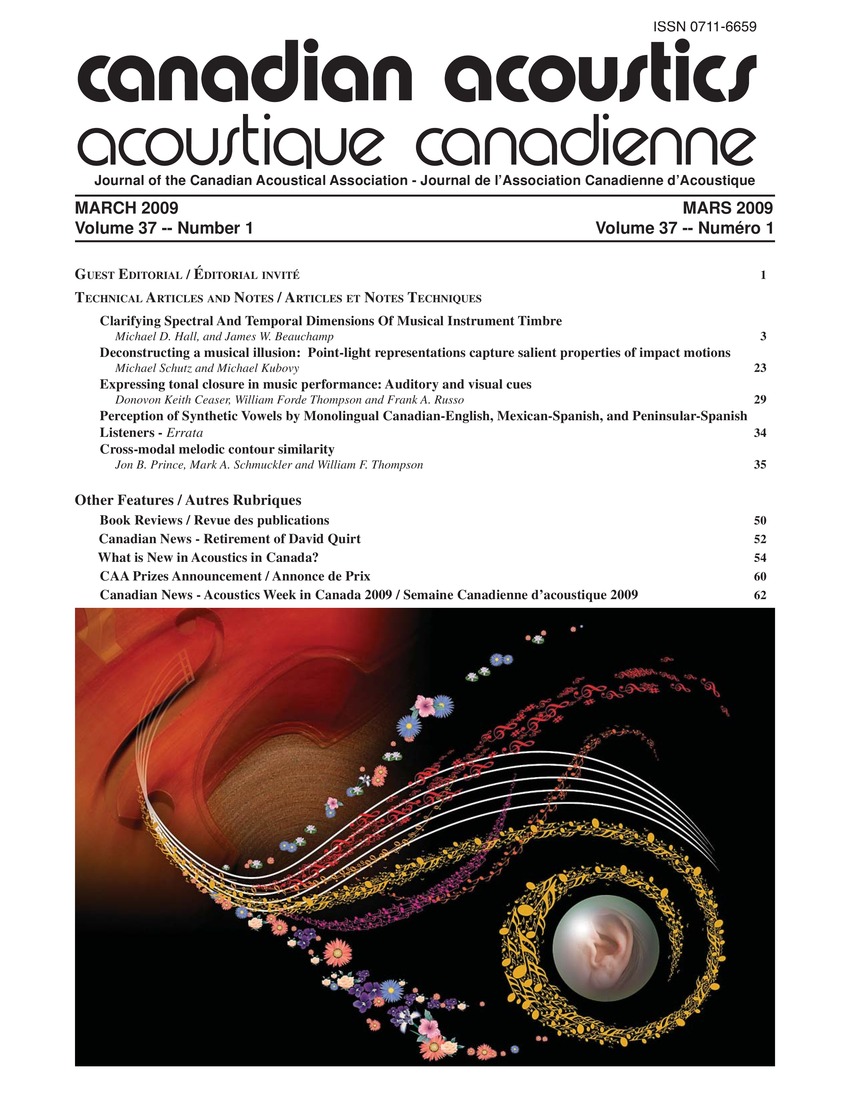Clarifying spectral and temporal dimensions of musical instrument timbre
Keywords:
Experiments, Instruments, Law enforcement, Low pass filters, Musical instruments, Sensitivity analysis, Spectrum analysis, Speech recognition, Amplitude envelopes, Binary features, Higher harmonics, Instrument identifications, Multi-dimensional scaling, Musical instrument sounds, Relative amplitudes, Rise time, Spectral changes, Spectral dimensions, Spectral envelopes, Temporal cues, Temporal dimensionsAbstract
Classic studies based on multi-dimensional scaling of dissimilarity judgments, and on discrimination, for musical instrument sounds have provided converging support for the importance of relatively static, spectral cues to timbre (e.g., energy in the higher harmonics, which has been associated with perceived brightness), as well as dynamic, temporal cues (e.g., rise time, associated with perceived abruptness). Comparatively few studies have evaluated the effects of acoustic attributes on instrument identification, despite the fact that timbre recognition is an important listening goal. To assess the nature, and salience, of these cues to timbre recognition, two experiments were designed to compare discrimination and identification performance for resynthesized tones that systematically varied spectral and temporal parameters between settings for two natural instruments. Stimuli in the first experiment consisted of various combinations of spectral envelopes (manipulating the relative amplitudes of harmonics) and amplitude-vs.-time envelopes (including rise times). Listeners were most sensitive to spectral changes in both discrimination and identification tasks. Only extreme amplitude envelopes impacted performance, suggesting a binary feature based on abruptness of the attack. The second experiment sought to clarify the spectral dimension. Listener sensitivity was compared for a) modifications of spectral envelope shape via variation of formant structure and b) spectral changes that minimally impact envelope shape (using low-pass filters to match the centroids of the formant-varied envelopes). Only differences in formant structure were easily discriminated and contributed strongly to identification. Thus, it appears that listeners primarily identify timbres according to spectral envelope shape. Implications for models of instrument timbre are discussed.Additional Files
Published
How to Cite
Issue
Section
License
Author Licensing Addendum
This Licensing Addendum ("Addendum") is entered into between the undersigned Author(s) and Canadian Acoustics journal published by the Canadian Acoustical Association (hereinafter referred to as the "Publisher"). The Author(s) and the Publisher agree as follows:
-
Retained Rights: The Author(s) retain(s) the following rights:
- The right to reproduce, distribute, and publicly display the Work on the Author's personal website or the website of the Author's institution.
- The right to use the Work in the Author's teaching activities and presentations.
- The right to include the Work in a compilation for the Author's personal use, not for sale.
-
Grant of License: The Author(s) grant(s) to the Publisher a worldwide exclusive license to publish, reproduce, distribute, and display the Work in Canadian Acoustics and any other formats and media deemed appropriate by the Publisher.
-
Attribution: The Publisher agrees to include proper attribution to the Author(s) in all publications and reproductions of the Work.
-
No Conflict: This Addendum is intended to be in harmony with, and not in conflict with, the terms and conditions of the original agreement entered into between the Author(s) and the Publisher.
-
Copyright Clause: Copyright on articles is held by the Author(s). The corresponding Author has the right to grant on behalf of all Authors and does grant on behalf of all Authors, a worldwide exclusive license to the Publisher and its licensees in perpetuity, in all forms, formats, and media (whether known now or created in the future), including but not limited to the rights to publish, reproduce, distribute, display, store, translate, create adaptations, reprints, include within collections, and create summaries, extracts, and/or abstracts of the Contribution.


